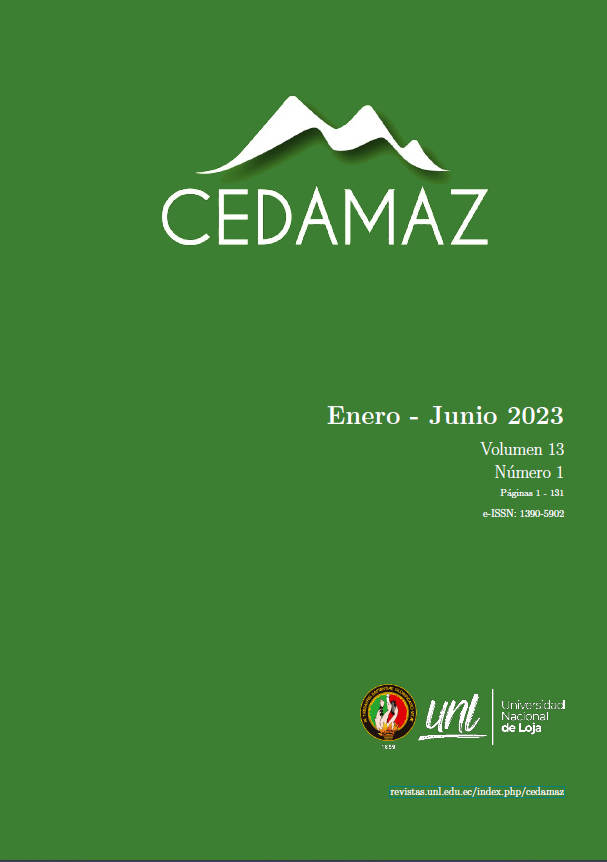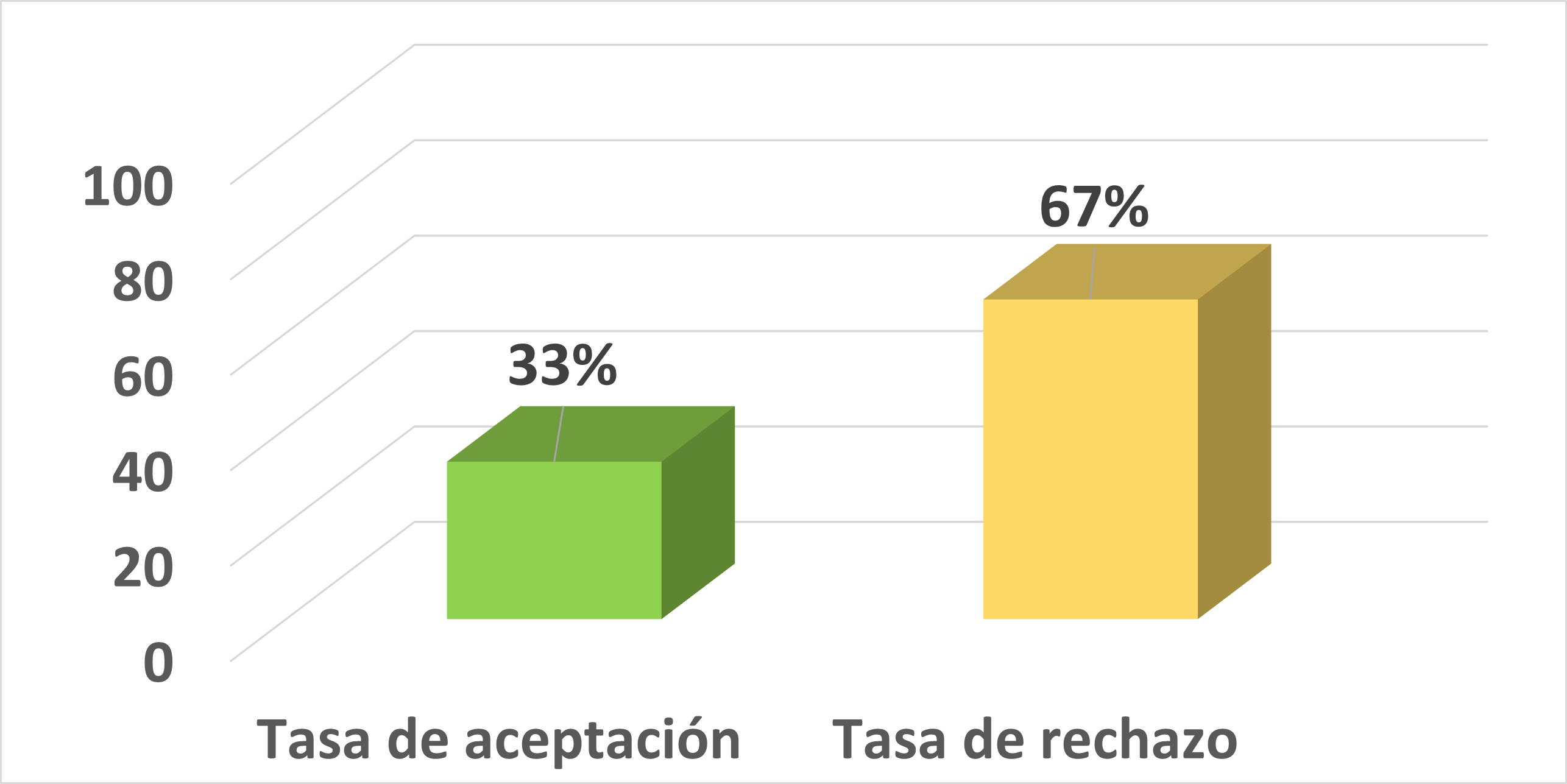Vocalización como marcador de estrés en ganado bovino
DOI:
https://doi.org/10.54753/cedamaz.v13i1.1763Palabras clave:
Bienestar animal, Vocalización, Ganado bovino, EstrésResumen
El incremento en el número de bovinos dificulta al granjero a observar y monitorear animales individualmente, evento influenciado con la salud emocional del animal. Conjuntamente, los consumidores actuales de los productos y subproductos bovinos exigen más control e información sobre el bienestar durante su producción. Varias metodologías son descritas para controlar y medir el bienestar animal. La vocalización o expresión vocal del animal puede ser medida y traducida a niveles emocionales positivos y negativos que interesan como marcadores o indicadores de estrés que aqueja a esta especie en particular. Por ello, el objetivo de esta revisión fue describir los eventos que influyen en el estrés del ganado bovino vinculados a métodos de identificación por expresión vocal. El uso de vocalizaciones como marcador de estrés para evaluar el bienestar del ganado bovino se ha discutido constantemente, no obstante, el contenido dinámico emocional manifestado por la vocalización o niveles de expresión vocal deberían ser más estudiados; claramente, se podría predecir y proporcionar un estado positivo emocional influenciando sobre la producción y bienestar de los animales.Citas
Andriamandroso, A., Bindelle, J., Mercatoris, B., & Lebeau, F. (2016). A review on the use of sensors to monitor cattle jaw movements and behavior when grazing. Biotechnologie, Agronomie, Société et Environnement, 20. https://hdl.handle.net/2268/197763
Bishop, J. C., Falzon, G., Trotter, M., Kwan, P., & Meek, P. D. (2019). Livestock vocalisation classification in farm soundscapes. Computers and electronics in agriculture, 162, 531-542. https://doi.org/10.1016/j.compag.2019.04.020
Buller, H., Blokhuis, H., Lokhorst, K., Silberberg, M., & Veissier, I. (2020). Animal welfare management in a digital world. Animals, 10(10), 1779. https://doi.org/10.3390/ani10101779
Burman, O. H., Ilyat, A., Jones, G., & Mendl, M. (2007). Ultrasonic vocalizations as indicators of welfare for laboratory rats (Rattus norvegicus). Applied Animal Behaviour Science, 104(1-2), 116-129. https://doi.org/10.1016/j.applanim.2006.04.028
Briefer, E. F. (2012). Vocal expression of emotions in mammals: mechanisms of production and evidence. Journal of Zoology, 288(1), 1-20. https://doi.org/10.1111/j.1469-7998.2012.00920.x
Briefer, E. F. (2020). Coding for ‘dynamic’information: vocal expression of emotional arousal and valence in non-human animals. Coding strategies in vertebrate acoustic communication, 137-162. https://doi.org/10.1007/978-3-030-39200-0_6
Charlton, B. D., Keating, J. L., Kersey, D., Rengui, L., Huang, Y., & Swaisgood, R. R. (2011). Vocal cues to male androgen levels in giant pandas. Biology Letters, 7(1), 71-74. https://doi.org/10.1098/rsbl.2010.0582
Darwin, C. (1852). La expresión de las emociones en el hombre y en los animales. https://idus.us.es/bitstream/handle/11441/118043/1/file_1.pdf?sequence=1
de la Torre, M. P., Briefer, E. F., Reader, T., & McElligott, A. G. (2015). Acoustic analysis of cattle (Bos taurus) mother–offspring contact calls from a source–filter theory perspective. Applied Animal Behaviour Science, 163, 58-68. https://doi.org/10.1016/j.applanim.2014.11.017
Ede, T., Lecorps, B., von Keyserlingk, M. A., & Weary, D. M. (2019). Symposium review: Scientific assessment of affective states in dairy cattle. Journal of dairy science, 102(11), 10677-10694. https://doi.org/10.3168/jds.2019-16325
Farokhnejad, S., Cardoso, D., Rocha, C., da Mata, A. S., & Menezes, R. (2023). A Data-Driven Approach to Cattle Epidemic Modelling Under Uncertainty. In Complex Networks XIII: Proceedings of the 13th Conference on Complex Networks, CompleNet 2022 (pp. 55-67). Cham: Springer International Publishing. https://doi.org/10.1007/978-3-031-17658-6_5
Ferrari, S., Silva, M., Guarino, M., & Berckmans, D. (2008). Analysis of cough sounds for diagnosis of respiratory infections in intensive pig farming. Transactions of the ASABE, 51(3), 1051-1055. https://elibrary.asabe.org/abstract.asp?aid=24524
Ferrari, S., Piccinini, R., Silva, M., Exadaktylos, V., Berckmans, D., & Guarino, M. (2010). Cough sound description in relation to respiratory diseases in dairy calves. Preventive veterinary medicine, 96(3-4), 276-280. https://doi.org/10.1016/j.prevetmed.2010.06.013
Grandin, T. (1988). Behavior of slaughter plant and auction employees toward the animals. Anthrozoös, 1(4), 205-213. https://doi.org/10.2752/089279388787058335
Green, A. C., Lidfors, L. M., Lomax, S., Favaro, L., & Clark, C. E. (2021). Vocal production in postpartum dairy cows: Temporal organization and association with maternal and stress behaviors. Journal of Dairy Science, 104(1), 826-838. https://doi.org/10.3168/jds.2020-18891
Green, A., C. Clark, L. Favaro, S. Lomax, & D. Reby. (2019). Vocal individuality of Holstein-Friesian cattle is maintained across putatively positive and negative farming contexts. Sci. Rep. 9:18468. https://doi.org/10.1038/s41598-019-54968-4
Green, A. C., I. N. Johnston, & C. E. F. Clark. (2018). Invited review: The evolution of cattle bioacoustics and application for advanced dairy systems. Animal 12:1250–1259. https://doi.org/10.1017/S1751731117002646
Göncü, S., & Bozkurt, S. (2019). Holstein cow vocalization behavior during oestrus periods. MOJ Ecology & Environmental Sciences 4: 276-279. https://doi.org/10.15406/mojes.2019.04.00165
Hanna, D., Sneddon, I. A., & Beattie, V. E. (2009). The relationship between the stockperson’s personality and attitudes and the productivity of dairy cows. Animal, 3(5): 737-743. https://doi.org/10.1017/S1751731109003991
Haro A. N. (2021). Relationship between operators and cows as they move from a conventional to an automatic milking system. Dairy Knowledge Center. https://dellait.com/operators-and-cows-in-an-automatic-milking-system/
Haro, A., Gonzalez, J., de Evan, T., de la Fuente, J., & Carro, M. D. (2019). Effects of feeding rumen-protected sunflower seed and meal protein on feed intake, diet digestibility, ruminal, cecal fermentation, and growth performance of lambs. Animals, 9(7), 415. https://doi.org/10.3390/ani9070415
Jung, D. H., Kim, N. Y., Moon, S. H., Kim, H. S., Lee, T. S., Yang, J. S., ... & Park, S. H. (2021). Classification of vocalization recordings of laying hens and cattle using convolutional neural network models. Journal of Biosystems Engineering, 46(3), 217-224. https://doi.org/10.1007/s42853-021-00101-1
Keltner, D., Tracy, J., Sauter, D. A., Cordaro, D. C., & McNeil, G. (2016). Expression of emotion. Handbook of emotions, 4, 467-482. https://ubc-emotionlab.ca/wp-content/files_mf/handbookofemotionschapterinpress.pdf
Kolacz, J., Lewis, G. F., & Porges, S. W. (2018). The integration of vocal communication and biobehavioral state regulation in mammals: A polyvagal hypothesis. In Handbook of behavioral neuroscience (Vol. 25, pp. 23-34). Elsevier. https://doi.org/10.1016/B978-0-12-809600-0.00003-2
Linhart, P., Ratcliffe, V. F., Reby, D., & Špinka, M. (2015). Expression of emotional arousal in two different piglet call types. PloS one, 10(8), e0135414. https://doi.org/10.1371/journal.pone.0135414
Meagher, R. K., Beaver, A., Weary, D. M., & von Keyserlingk, M. A. (2019). Invited review: A systematic review of the effects of prolonged cow–calf contact on behavior, welfare, and productivity. Journal of dairy science, 102(7), 5765-5783. https://doi.org/10.3168/jds.2018-16021
Mellor, D. J. (2016). Updating animal welfare thinking: Moving beyond the “Five Freedoms” towards “a Life Worth Living”. Animals, 6(3), 21. https://doi.org/10.3390/ani6030021
Moore, R. K., Marxer, R., & Thill, S. (2016). Vocal interactivity in-and-between humans, animals, and robots. Frontiers in Robotics and AI, 3, 61. https://doi.org/10.3389/frobt.2016.00061
Navon, S., Mizrach, A., Hetzroni, A., & Ungar, E. D. (2013). Automatic recognition of jaw movements in free-ranging cattle, goats and sheep, using acoustic monitoring. Biosystems Engineering, 114(4), 474-483. https://doi.org/10.1016/j.biosystemseng.2012.08.005
Neethirajan, S. (2021). Happy cow or thinking pig? Wur wolf—facial coding platform for measuring emotions in farm animals. AI, 2(3), 342-354. https://doi.org/10.3390/ai2030021
Panksepp, J. (2005). Affective consciousness: Core emotional feelings in animals and humans. Consciousness and cognition, 14(1), 30-80. https://doi.org/10.1016/j.concog.2004.10.004
Proctor, H. S., & Carder, G. (2015). Measuring positive emotions in cows: Do visible eye whites tell us anything?. Physiology & behavior, 147, 1-6. https://doi.org/10.1016/j.physbeh.2015.04.011
Reby, D., Wyman, M. T., Frey, R., Passilongo, D., Gilbert, J., Locatelli, Y., & Charlton, B. D. (2016). Evidence of biphonation and source–filter interactions in the bugles of male North American wapiti (Cervus canadensis). Journal of Experimental Biology, 219(8), 1224-1236. https://doi.org/10.1242/jeb.131219
Reefmann, N., Wechsler, B., & Gygax, L. (2009). Behavioural and physiological assessment of positive and negative emotion in sheep. Animal Behaviour, 78(3), 651-659. https://doi.org/10.1016/j.anbehav.2009.06.015
Ruggieri, V. L. (2013). Empatía, cognición social y trastornos del espectro autista. Revista de neurología, 56(1), 13-21. https://www.amece.es/images/autismo11.pdf
Schnaider, M. A., Heidemann, M. S., Silva, A. H. P., Taconeli, C. A., & Molento, C. F. M. (2022). Vocalization and other behaviors as indicators of emotional valence: The case of cow-calf separation and reunion in beef cattle. Journal of Veterinary Behavior, 49, 28-35. https://doi.org/10.1016/j.jveb.2021.11.011
Silva, M., Exadaktylos, V., Ferrari, S., Guarino, M., Aerts, J. M., & Berckmans, D. (2009). The influence of respiratory disease on the energy envelope dynamics of pig cough sounds. Computers and electronics in agriculture, 69(1), 80-85. https://doi.org/10.1016/j.compag.2009.07.002
Shorten, P. R., & Hunter, L. B. (2023). Acoustic sensors for automated detection of cow vocalization duration and type. Computers and Electronics in Agriculture, 208, 107760. https://doi.org/10.1016/j.compag.2023.107760
Tate, A. J., Fischer, H., Leigh, A. E., & Kendrick, K. M. (2006). Behavioural and neurophysiological evidence for face identity and face emotion processing in animals. Philosophical Transactions of the Royal Society B: Biological Sciences, 361(1476), 2155-2172. https://doi.org/10.1098/rstb.2006.1937
Vandermeulen, J., Bahr, C., Johnston, D., Earley, B., Tullo, E., Fontana, I., ... & Berckmans, D. (2016). Early recognition of bovine respiratory disease in calves using automated continuous monitoring of cough sounds. Computers and Electronics in Agriculture, 129, 15-26. https://doi.org/10.1016/j.compag.2016.07.014
Watts, J. M., & Stookey, J. M. (2000). Vocal behaviour in cattle: the animal's commentary on its biological processes and welfare. Applied Animal Behaviour Science, 67(1-2), 15-33. https://doi.org/10.1016/S0168-1591(99)00108-2
Wildridge, A. M., Thomson, P. C., Garcia, S. C., Jongman, E. C., & Kerrisk, K. L. (2020). Transitioning from conventional to automatic milking: Effects on the human-animal relationship. Journal of dairy science, 103(2), 1608-1619. https://doi.org/10.3168/jds.2019-16658
Publicado
Cómo citar
Número
Sección
Licencia
Derechos de autor 2023 CEDAMAZ

Esta obra está bajo una licencia internacional Creative Commons Atribución-NoComercial-SinDerivadas 4.0.
Aquellos autores/as que tengan publicaciones con esta revista, aceptan los términos siguientes:
-
Luego que el artículo científico es aceptado, para su publicación el o la autora aceptan ceder los derechos de la primera publicación a la Revista CEDAMAZ, conservando sus derechos de autor. Se permite la reproducción total o parcial de los textos que se publican siempre y cuando sea sin fines de lucro. Cuando se ejecute la reproducción total o parcial de los artículos científicos aceptados y publicados en la revista CEDAMAZ, se debe citar la fuente completa y la dirección electrónica de la publicación.
-
Los artículos científicos aceptados y publicados en la revista CEDAMAZ pueden ser depositados por los autores de manera integra en cualquier repositorio sin fines comerciales.
-
Los autores no deben distribuir los artículos científicos aceptados, pero que todavía no han sido publicados oficialmente por la revista CEDAMAZ. En el caso de incumplir esta norma implica el rechazo del articulo científico.
- La publicación de su obra, el cuál estará simultáneamente sujeto a la Licencia de reconocimiento de Creative Commons









